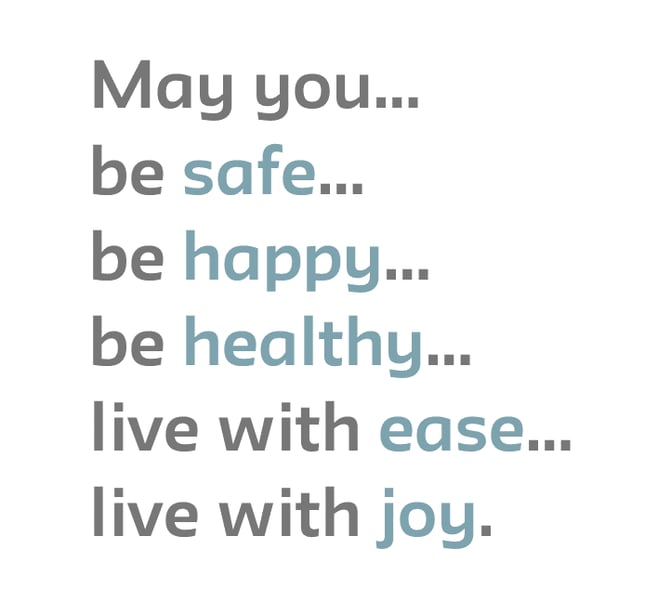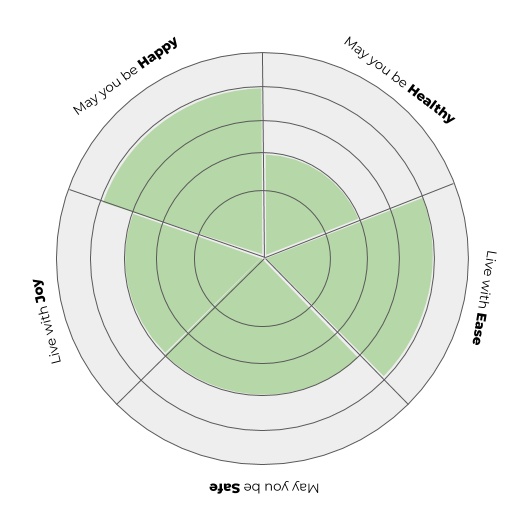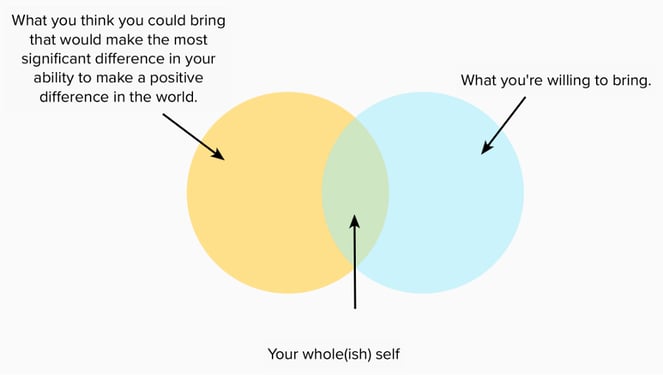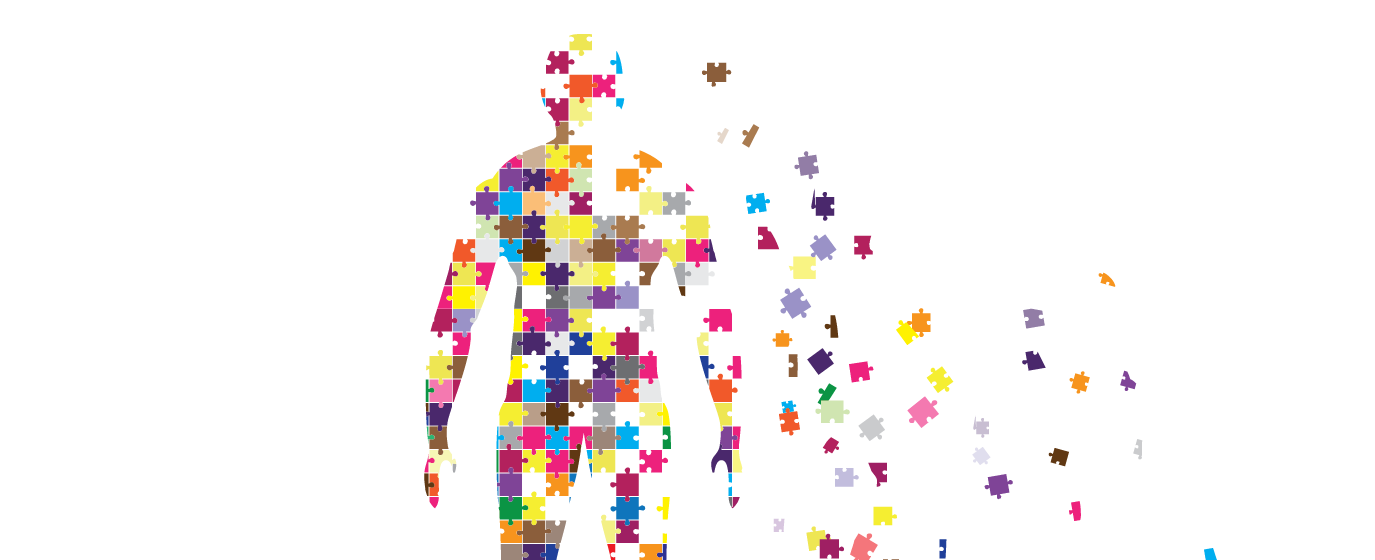Bring Your Whole(ish) Self to Work
Big Ideas | Leadership | People Operations | Inclusion | Work Life Balance
Applying a Lovingkindness Lens
by Tim Cynova, Chief Operating Officer at Fractured Atlas

Remember when it seemed like everyone was trying to achieve “work-life” balance? More recently, perhaps in a nod to the challenges of balancing “work” and “life” in an always-connected world, or maybe because for those searching for meaning and purpose in their activities there’s not always a bright line distinction between “work” and “life,” the phrase has shifted to “bringing our whole selves to work.”
Well, with my HR hat on, it’s typically people who bring their whole selves to work who are the ones the HR folks need to have meetings with, or about. So, I’d like to propose a slight reframing: let’s aim to bring our whole(ish) selves to work. 85% of ourselves is probably just about the right calibration.
Why 85%?
In the end, not even our closest friends and family *really* want us to bring 100% of ourselves to our interactions. Yes, be present, genuine, and authentic. But no to bringing every single piece of us into the space. When we do bring 100% of ourselves into a space, how might that actually make it more challenging for others to show up more fully themselves?
 Not scientific.
Not scientific.
I’ll bet most people don’t exceed the 50% mark though. For many, it’s less about how to dial back from 100% and more about what conditions would be necessary to bring a little (or a lot) more of themselves.
Looking at this through the lens of building high-performing teams — where people can thrive — we can see even clearer why aiming for everyone to move towards 85% might be the better pursuit.
Psychological Safety & Diversity in Teams
Research shows that two traits of high-performing teams are psychological safety — the ability for people to participate without fear of retribution (the ol’ getting your legs kicked out from under you when you say something the boss doesn’t agree with) — and that teams are diverse in as many ways as possible. Both of these play significantly into people feeling comfortable bringing more of themselves to work.
Here’s just a sampling of the ways diversity can show up in our organizations: sex, gender, age, race, religion, national origin, ethnicity, disability, sexuality, income, learning modalities, education, culture, customs, life or prior work experiences, networks, style, speech, lineage, origins, political beliefs, appearance, and work styles (just to name a few).
Thinking about where people calibrate themselves with regards to that 85%, I imagine in U.S. corporate culture, aside for a number of heterosexual, White, cis-gender men in positions of power (or perceived power), many others feel a struggle of varying levels to bring their wholes selves to work, and/or are conflicted about what and how much they want to bring of themselves. This creates a drag on people’s ability to be authentic, do their best work, and thrive. And the sad fact here is that while we’re talking about bringing our whole selves to work, some of our colleagues are likely comfortable bringing only about 20% of themselves to their work.
How much richer and more meaningful would our organizations be if everyone felt comfortable bringing 85% of themselves to work?
How much more meaningful and engaged might someone be if they felt they could go from bringing 20% of themselves to, say, 60%? How might this result in more of us being able to fulfill our organizational missions and our personal search for purpose?
As we work to build more inclusive, diverse, and/or equitable teams and organizations, it’s incumbent upon those of us in positions of leadership — wherever we lead from in our organizations — to do whatever we can to assist in creating an environment that’s supportive of everyone bringing more of themselves to their work (and pointing out for those few people who might need to dial it back, when that’s appropriate too).
Why is this important?
First, because it’s the morally right thing to do. If leaders aren’t continually trying to make progress in supporting those who work for their organizations, they are failing at a core leadership responsibility. However, if we can’t agree there, let’s move more to the business case.
I’ve written about how research shows the vast majority of people who work at our organizations are disengaged from their work, and that more than half are looking for new jobs. (Quick recap: Gallup Worker Engagement Index found that roughly 85% of employees are disengaged and 51% of employees are looking for another job.) Recent research adds to that to show that disengagement and satisfaction in work — and the ability to “bring one’s whole self to work” — disproportionately, negatively impacts our colleagues of color.
In one study, researchers found that 38% of our Black colleagues feel it’s never appropriate in the workplace to talk about the bias they experience in life. This makes them twice as likely as those not in this group to experience feelings of isolation, three times as likely to have one foot out the door and be looking for another job, and 13 times as likely to be disengaged in their work.
And this is just as it relates to our colleagues of color. I’m confident that if we looked at findings as they related to other aspects of diversity we’d find similar disheartening results.
The Lovingkindness Lens
I’ve been meditating for a few years now. For those fellow meditators, you’ll be familiar with the Lovingkindness, or metta, meditation. For those less familiar, it basically goes like this: you meditate on phrases like, “May you be safe, be happy, be healthy, live with ease, live with joy,” while focusing first on yourself; then focusing on someone close to you. Next, you focus on someone you know but don’t really know (think of the Starbucks barista you see each morning). Then, you move to someone who really challenges you; and finally, to all beings everywhere.

When I was meditating on these phrases a few months back, I had an epiphany. The Lovingkindness meditation provides an excellent lens to use when seeking to identify blockers for bringing more of oneself to work.
It works like this: how safe is your workplace? Not necessarily physical safety (although that certainly might be part of it) but psychologically safety. How happy are you and your coworkers? How easy is it for you to do your work? Easy as in it doesn’t feel like people keep throwing obstacles in your way at every turn, not that your work isn’t challenging in a good way.
As I meditated on this, I was struck by one of the greatest ironies of the cultural sector. Our sector exists, in large, part to make the world a better, more beautiful and understanding place. And sadly — both anecdotally and backed by research — most people are unfulfilled (and some are downright miserable) doing the work. At what cost are we trying to achieve our charitable missions if we do it by blowing through and burning out our people?
At what cost are we trying to achieve our charitable missions if we do it by blowing through and burning out our people?
When we use Lovingkindness’s “healthy” lens here the shit gets real, fast. How many hours are people working? (And how much work is supposed to be accomplished during that period?) How many people don’t feel like they can step away from their desks for lunch? How many people feel like they can’t take more than a few vacation days a year? And when they do get away, they feel pressure — real or implied — to stay connected to email and voicemails.
Next, let’s use the “work with ease” lens. Again, this doesn’t mean work is easy, it’s that it doesn’t always feel like you’re pushing an ever-larger boulder up an increasingly steep mountain. “All I want to do is send out the annual appeal letters. Why does it feel like I’m participating in some Tough Mudder competition?!” And lastly, does your work bring you joy? If you personally can’t positively answer *that* question, again, I ask at what cost are we doing this work? Life is simply too short.
 Some might find it helpful to plot their current positions on a Lovingkindness chart like the one above
Some might find it helpful to plot their current positions on a Lovingkindness chart like the one above
Let’s then ask ourselves, when reflecting on safety, happiness, health, ease, and joy in our workplace, how many of our coworkers can honestly say yes to those things? Is it just the executive director? Or, oh God, maybe not even the executive director. We might not like the results, but burying our head in the sand doesn’t mean that it’s not true. I can’t think of an organization that can check off all of these for every single person. However, (1) that’s no excuse for us not to continually be doing something about it, and (2) this Lovingkindness lens gives us a quick “balance sheet” or snapshot to start using. This snapshot highlights the often amorphous “organizational culture” components so we can pull them apart and begin identifying ways to address them.
The Lovingkindess Lens in Action
The beauty of using the Lovingkindness lens is that it can be applied at the individual, team, and organizational levels. Ask yourself first, do I feel safe in my work and workplace? Why or why not? What does safety at work look and feel like? What would help me to feel safer? Then, am I happy in my work? What would need to change for me to find daily happiness and joy in my work? What part of my work always feels like an unnecessary struggle? (At this point, you might find a job crafting exercise to be quite helpful.)
 Sometimes, to bring our whole(ish) selves to work, we need a little help from our friends and colleagues
Sometimes, to bring our whole(ish) selves to work, we need a little help from our friends and colleagues
Then, take it the next step and ask, who on my team or in my organization might not feel safe? Who might not be happy in their work? Then, before running to them as saying — “Hey, why don’t you feel safe to bring more of yourself to work?” — interrogate your assumptions. Why do you think that? What gives you that impression? If someone doesn’t feel psychologically safe at work, they’re probably not going to give you an honest answer to that question anyways. There likely is work that needs to be done in the organization before you will see progress here. (For more on building psychologically safe workplaces, check out the awesome work by Amy C. Edmondson.)
And lastly, expand this beyond people on staff to consider your board, your volunteers, and those you’re trying to serve. First, how engaged are they in the work? Are they happy with us? Do we help those we serve to be healthy? How easy is it for people to participate in our work? You will likely need to take a few liberties to map these lenses to your organization, but going down the list to articulate “What does safety look like for those we serve?” “How might what we do make it easier for people?” is a helpful starting place.
What can I do right now to move towards what I really want?

As we think about the 85% we aim to bring, about safety, happiness, health, ease, and joy — how do we decide what we’re comfortable bringing into a space? And how do we actually do it? Meditating on what to bring will surface things that are personal and bespoke to each of us. We’ll likely discover there’s a Venn diagram of sorts with two components: What you think you could bring that would make the most significant difference in your ability to make a positive difference in the world, and What you’re willing to bring.
We have but one pass at this life. If we’re doing it while overly throttling who we are as humans, to the detriment of ourselves, our ability to achieve our potential and make our dent in the universe, at what cost is this to us truly living? Showing up more fully — especially when it doesn’t inhibit someone else’s humanity — should be a goal we all feel that we can strive towards.
About Tim Cynova
Tim wears a multitude of hats, all in service of creating anti-racist workplaces where people can thrive. He currently is co-CEO of Fractured Atlas (an entirely virtual organization with staff spread across multiple states and countries) and a Principal of the consulting group Work. Shouldn't. Suck. He serves on the faculty of Banff Centre for Arts & Creativity and The New School teaching courses in People-Centric Organizational Design; he's a trained mediator, and a certified Senior Professional in Human Resources (SPHR). Earlier in his career, Tim was the Executive Director of The Parsons Dance Company and of High 5 Tickets to the Arts in New York City, had a memorable stint with the Cincinnati Symphony Orchestra, was a one-time classical trombonist, musicologist, and for five years in his youth he delivered newspapers for the Evansville, Indiana Courier-Press. Also, during a particularly slow summer, he bicycled 3,902 miles across the United States.


